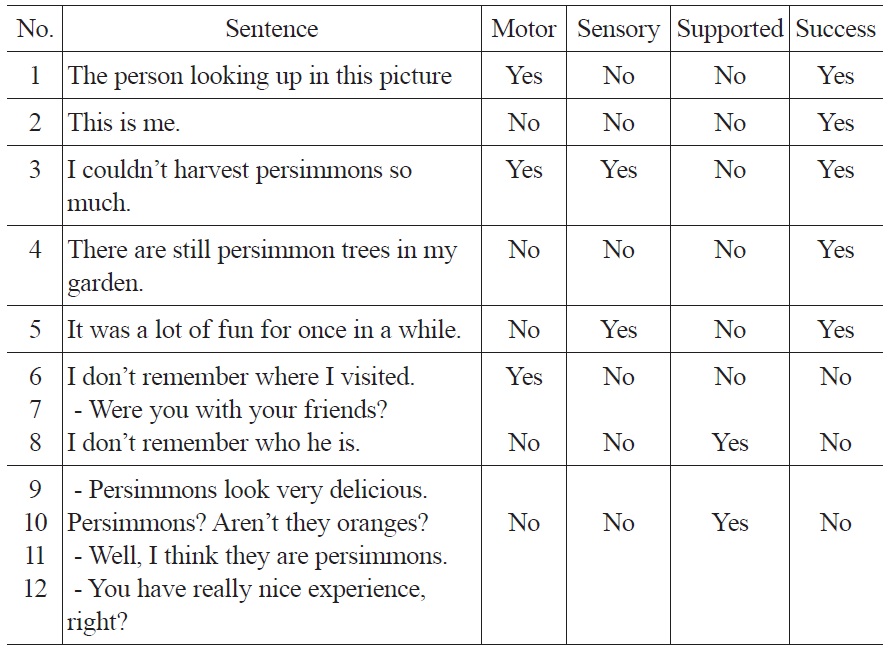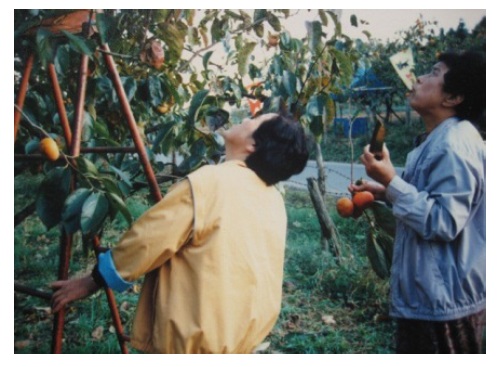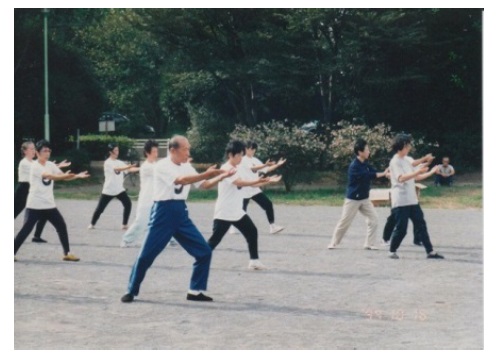


It has been widely noticed that the world is facing a rapidly aging population. In the United States for example, it is expected that the proportion of the population over the age of 65 will increase to 20.3% in 2050 from 12.7% in 2000 (Wiener & Tilly 2002). A similar trend is also seen in Japan, where the percentage of the people aged 65 or above will reach 35.7%, meaning 1 in 2.8 people, by 2050 (National Institute of Population and Social Security Research, 2012). One of the societal challenges resulting from this condition is the fact that many older adults are expected to need physical and cognitive assistance. Alzheimer’s and other forms of dementia and cognitive impairment are among the major causes. It is estimated that the number of people suffering from Alzheimer’s disease will increase to 100 million worldwide by 2050 (Alzheimer’s Association 2011; Tapus et al. 2008). Due to progressive brain dysfunction that impairs cognition, people suffering from dementia will be in need of special care that includes a type of treatment with meditation and psychological therapies even though they might not completely cure the mental problems (Tapus et al. 2008).
Given the urgent need of solution to such treatment processes, there has been much research focusing on the different techniques in psychological therapy to maintain or rehabilitate cognitive abilities like memory, orientation and communication skills (Tapus et al. 2008; Kidd et al. 2006; Stuss et al. 2007; Tapus & Mataric 2008; Ceccato et al. 2012; Reijndersa et al. 2013). However, it is still not fully clarified how psychological therapies could effectively improve cognitive function which influences everyday life activities (Papp et al. 2009; Martin et al., 2011), and indeed, for dealing with such a fundamental problem, it may even be necessary to revisit the most basic question such as “what cognition is in the first place”.
The traditional viewpoint in cognitive science considered human cognition as abstract information processing performed by the brain, where the perceptual and motor systems were thought to serve merely as peripheral input/output devices. Although this viewpoint has historically contributed to the development of cognitive science and its applications, more recently there has been an increasing interest in the concept of embodied cognition, which emphasizes the mportance of sensory and motor functions, along with their interaction with the environment. In other words, human cognition is viewed as processes deeply rooted onto physical sensorimotor interactions rather than those being centralized and solely separated from the sensory and motor functions (Wilson 2002; Pfeifer & Bongard 2007; Clancey 1997).
Very briefly, the viewpoint of embodied cognition can be characterized by the following claims (Wilson 2002): (1) Cognition is situated. It takes place in real world environment, and therefore inherently involves perception and action (2) Cognition is time pressured. As also emphasized in (Clark 1997), cognition must be understood in terms of how it functions under real time pressures due to the interaction with the environment (3) Cognitive work is off-loaded onto the environment. Due to the limitation of our informationprocessing abilities, the environment is exploited to reduce the cognitive workload (4) Environment is a part of the cognitive system. Due to dense and continuous flow between the mind and the environment, it is not meaningful to analyze the mind alone without the environment (5) Cognition s for action. Cognitive mechanisms like perception and memory must be nderstood in terms of their contribution to situation appropriate behavior, it is because the function of the mind is to guide action (6) Off-line cognition is body based. The activity of the mind is grounded in the evolved sensor processing and control echanism for interaction with the environment, even when the mind is decoupled from the environment.
From the viewpoint of embodied cognition, how can we improve our psychological techniques to rehabilitate people suffering from dementia? As one of the main challenges of this research direction, we consider the problem of human memory in this article based on the concepts developed in the embodied cognition approach. Conventionally, human memory has been studied in a part of brain science where the hippocampus was widely studied, for example, as the major player for the formation of memory (Manns & Eichenbaum 2009). There are also the other studies which suggest that memory cannot simply be localized to a particular brain region but distributed (Naghavi & Nyberg 2005). Regardless of the different regions of human brains they studied, many of these researches in the brain science attempt to describe memory based on the so-called “storehouse metaphor” (Koriat & Goldsmith 1996). Here it was suggested that memories are stored in particular locations in the brain, and therefore can be later retrieved. However, the storehouse metaphor follows the classical view of cognition as computation and assumes that a brain works in a similar way to man-made computers. This traditional idea introduces several problems, such as where the entities are stored in the brain, or how they are related with the remembered event and with each other (Pfeifer & Bongard 2007). Stored structure perspective suggested to view memory as a stored structure, or representation, yet there were many phenomena that can be hardly explained within this perspective (Pfeifer & Bongard 2007).
In contrast, the concept of embodiment provides a fairly different perspective in understanding cognitive processes of human memory. Typically human memory is viewed as an emergent dynamics that is a result from the physical system-environment interactions involving rich motor actions and sensing/perception (Pfeifer & Bongard 2007). The way sensorimotor functions affect different types of memory was also suggested in previous research. For example, working memory, which is a short-term memory referred to when describing human capability to plan and carry out behavior (Cowan 2008), offloads information onto perceptual and motor control systems in the brain. Also it was reported that phonological similarity causes worse memory for words that sound alike. Episodic memory, which is a long-term memory represents experiences consisting of records of spatiotemporally localized events (Wilson 2002), is possibly the most obvious example of how memory is tied with our body’s experiences. And finally, implicit memory, which is the means that enables us to learn skills, was also argued to be an embodied form of knowledge (Wilson 2002). As exemplified in these studies, many human cognitive processes can be nicely explained, or at least characterized, by the notions of embodiment, thus we expect significant contributions to psychological therapeutic methods through further investigations of this approach.
From this perspective, the paper aims to discuss the issues of embodied cognitive science and their contributions in the psychological therapeutic method. Through a few case studies that we conducted in the last few years, we introduce a novel therapeutic method, the so-called coimagination method, which has been used for preventing and rehabilitating cognitive decline, and its implications in the context of embodied cognition.
The rest of the paper is organized as follows. In section 2, we first explain a more detail knowledge related with coimagination method, before describing an implementation trial of coimagination method, conducted in an adult day-care center. In section 3, we analyze the trial based on the assumption that embodied cognition may play an important role in determining the effectiveness of the method. Finally, we discuss the key issues relevant to the analysis, and propose the future direction of the research.
In this section, we further explain coimagination method, a therapeutic method for the prevention and rehabilitation of cognitive decline based on the idea of reminiscence therapeutic methods. Reminiscing, the process of “life review,” has been argued as an important part of old age. As a result, the reminiscence therapeutic method has become possibly one of the most popular therapeutic methods for older adults (Butler 1963). Originally proposed for improving mental health, later it was also applied to dementia treatment and prevention (Webster & Haight 1995). The core symptom in dementia is memory impairment, an increased difficulty in recalling once familiar information or events. The key issue of reminiscence therapeutic methods is therefore to help sharpen and maintain memory recall skills of older adults, possibly with supporting tools like photos and videos (Cohen 2000; Yasuda et al. 2009; Craik 1986).
“Coimagination method” is proposed by Otake, as a psychological therapeutic method to support the memory recall skill of older adults in a systematic manner (Otake 2009; Otake et al. 2011; Otake 2011). Unlike classical reminiscence therapies, coimagination method emphasizes the importance of memories resulting from interaction with the environment, and active participation of the older adults. The coimagination method is defined by these following rules:
A series of trials of implementing coimagination method have been conducted at hospitals and adult day-care centers (Otake et al. 2012). These trials have been successfully conducted through collaboration between practitioners, local government officials and healthy older adults. In the following sections, one of the trials of implementing coimagination method conducted in an adult day-care center is described.
The participants of the trial are older adults who visited an adult day-care center in Kashiwa, Japan. The total numbers of participants was five: the first three were healthy older adults while the last two were patients with mild dementia. Here, the first three participants are referred to as P1-P3, and the last two as P4-P5. Participants P1-P4 are women, and P5 is a man. The average age of the participants is 89.2 ± 6.8 years.
The materials are photos collected by participants, their families, or taken by practitioners based on preliminary interviews with the participants and their families. The photos were collected in a preparatory stage, one week prior to a conversation stage involving the participants.
As alluded to in the previous section, the coimagination method consists of two stages: the preparatory stage and the group conversation stage. In the preparatory stage, participants themselves prepare photos relevant to the topic. If it is difficult for participants to prepare the photos by themselves due to the cognitive decline, their families or caregivers prepare the photos which may help the participant to recall specific memories. If there are no appropriate photos, practitioners take photos of suitable objects. If it is possible, the participants can also take the photos by themselves, with the possible assistance from the practitioners. Finally, the collected photos are registered in the coimagination support system. Written consent for displaying the photos and analyzing the conversations must be obtained from all participants or their representatives.
In the group conversation stage, the participants’ seats are arranged around a screen. One of the practitioners operates the coimagination support system to display the photos according to the seating order and allocated time, which in this case is ten minutes for each participant. Ideally, the participant should be able to describe a photo within the first half of the allocated time, while the second half is used for a question and answer session involving other participants. However, if it seems too difficult for a participant to describe the photo by him/herself, practitioners start giving empathetic comments and questions to support him/her for recalling the memory. Therefore, the description session may take longer than the first half of the allocated time.
The number of photos described by the healthy older adults should be three. However, for older adults with cognitive decline, it is difficult to keep or quickly shift their attention. Therefore, the number of photos can be reduced. There should also be at least one practitioner, who both operates the support system and moderate the group conversation. The potential themes of the photos include but are not limited to: “favorite things”, “foods and healthcare,” or “jokes and funny mistakes”. In this particular implementation, the theme is “food and healthcare”, and the number of is three.
The participants’ verbal description about the photos is analyzed by counting the number of sentences used and classifying them as explained further in Tables 1 and 2. The approach of analyzing verbal descriptions based on the type of words used exists in the literature (Hegarty et al. 2005). In this paper, the aim of the classification is to discuss whether there is a relationship between the number of sensorimotor related words and indication of successful memory recall. Therefore, we employ a simple and general approach which can be explained as follows.
[Table 1.] Successful combinations of question-and-answer or spontaneous comments
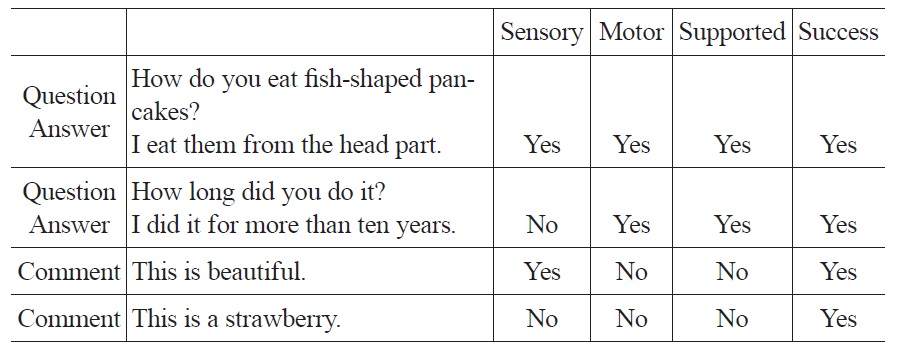
Successful combinations of question-and-answer or spontaneous comments
[Table 2.] Failed combinations of question-and-answer or spontaneous comments

Failed combinations of question-and-answer or spontaneous comments
Tables 1 and 2 show the examples of how indication of successful and failed memory recall is considered in this paper, including the possible supporting questions from the practitioners. For instance, the sentence “I eat them from the head part.” contains a word related with the motor process “eat”, and the sensory process “from the head part”. The sentence “I did it for more than ten years” contains the motor process related word “do”. We do not include “how long” and “for more than ten years” as words that involve sensory processes since the time-length of an experience cannot be detected directly by sensory systems. The sentence “This is beautiful.” contains a word related with a sensory process. However, we do not consider the sentence “This is a strawberry” to contain either sensory or motor processes, but merely semantic information.
Table 2 shows the example sentences that demonstrate how an indication of a failed memory recall is considered in this paper. The first sentence in Table 2, “I don’t remember where I visited” contains a word related with the motor process “visit”, but doesn’t contain any words related with sensory processes. The participant also indicates clearly that he cannot recall the memory of the place he visited. The last sentence in Table 2, as an answer to the question from the practitioner: “Were you with your friend?” doesn’t contain sensory or motor processes. It is also shown here that the participant cannot remember the semantic information “who”.
This section describes the analysis of the trial conducted. We firstly present examples of participants’ description and how they are categorized, before analyzing the result of categorization.
3.1 Examples of Participants’ Descriptions
Table 3 shows examples of sentences uttered by participant P1, a healthy older adult, to describe the photo shown in Figure 1. The sentences are classified by whether they contain words related with sensory and/or motor processes. Participant P1 was able to describe the story without any support from the practitioner. As explained in section 2.4, here P1 is considered to indicate successful memory recalls for each sentence she uttered. According to the proposed classification explained in section 2.4, it can also be observed that the first, fifth and sixth sentences contain words related with motor processes: “receive” and “take”. The second, third, fourth and eighth sentences contain words related with sensory process: “brilliant”, “pretty”, “delicious looking”, and “sweet”. The seventh sentence doesn’t contain any words related with sensory or motor processes.
Parts of the sentences uttered by P4, a participant with mild dementia, are shown in Table 4. The corresponding photo is shown in Figure 2. The sentences are classified by whether they contain sensory and/or motor processes, whether the participants were supported by the practitioners, and whether it can be considered that the participants indicate successful memory recall based on the proposed classification explained in section 2.4. The participant P4 could describe the topic by herself at the beginning, as seen in the first to sixth sentences. Then, a practitioner supported her by asking questions and comments, as seen in the seventh sentence, because she started wondering and stopped describing. The eighth and tenth sentences are the responses to the supporting questions. However, the support was not successful and participant P4 failed to continue her description. Neither the seventh nor the tenth sentence contains words related with sensory or motor processes. Oppositely, the first, third and sixth sentences contain words related with motor processes: “look”, “harvest”, and “visit”. he third and fifth sentences contain words related with sensory processes: “so much”, and “fun”.
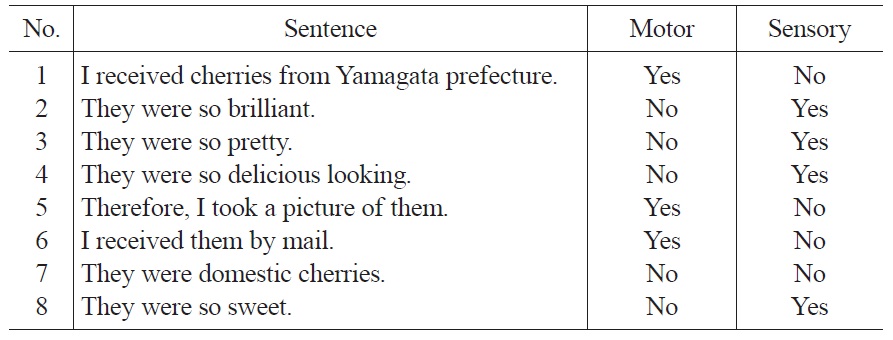
Example of a description by a healthy older adult, P1, and the classification of the sentences
Parts of sentences uttered by P5, a participant with mild dementia, are shown in Table 5. The corresponding photo is shown in Figure 3. The participant P5 could describe the topic by himself in the beginning as seen in the first to seventh sentences. Then, a practitioner supported him by giving a comment on the photo. As a result, he described the photo further, and here it is considered as an indication of successful memory recall. From Table 5, it can also be seen that eight out of nine sentences uttered by P5 contained motor processes related words “do”, “feel”, “stop”, “teach”. Four out of nine sentences contained sensory processes “fine”, “reluctant”, “good”, and “so much”.

Example of a description by an older adult with mild dementia, P4, and the classification of the sentences
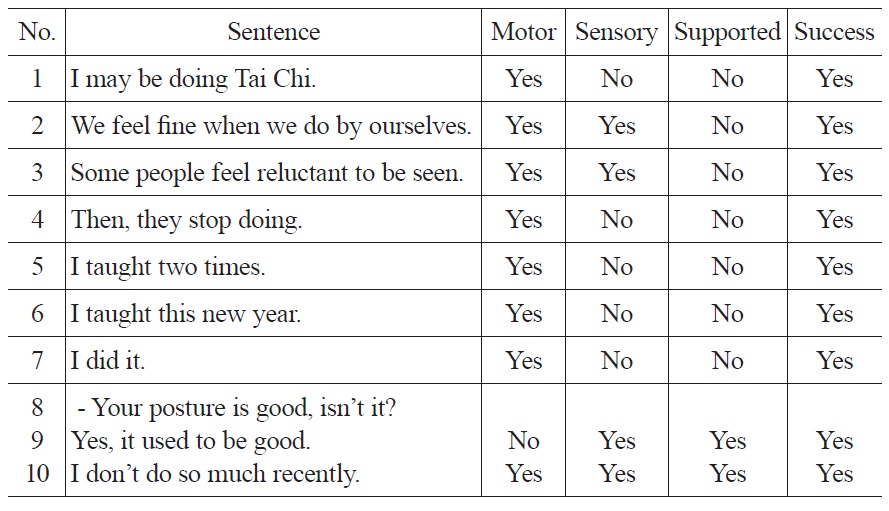
Example of a successful description by an older adult with mild dementia, P5, and the classification of the sentences
The number of sentences from the descriptions performed by each participant is numbered and classified, and the result is shown in Table 6. The Success Rate shows the percentage of the number of time when there are indication of successful memory recalls, out of the total number of sen- tences uttered by the participant. The highest Success Rate was 100[%] for P1 and P2, who are healthy older adults. The lowest Success Rate was 59[%] for P4, an older adult with mild dementia. If a sentence uttered by the participant is a response to supporting questions from the practitioners, the sentence is considered as a supported sentence. The Support Rate is defined as the number of the supported sentences divided by the total number of sentences uttered by a participant.
[Table 6.] Total Number of Sentences, Support Rate and Success Rate of sentences

Total Number of Sentences, Support Rate and Success Rate of sentences
In summary, healthy older adults without dementia, P1 and P2, had a 100[%] Success Rate without any supports. Although P3 was also a healthy older adult, it is interesting to notice that she had a relatively high Support Rate with a Success Rate of 86[%]. Older adults with dementia, P4 and P5, also occasionally needed support.
We also count the number of sentences containing words related with a sensory process and/or a motor process, shown in Table 7. For example, when the uttered sentences include both sensory and motor processes related words, the Success Rate was always 100[%], for all participants.
From the analysis of the trial, it can be observed that the Success Rate for the healthy older adults was between 86 and 100[%], while for those with mild dementia was between 59 and 90[%]. Additionally, the Support Rate for healthy older adults was between 0 and 71[%], and for older adults with dementia was between 50 and 55[%]. By categorizing the sentences according to the rules explained in section 2.4, it is interesting to notice that aside from participant P1 and P2 with a Success Rate of one hundred percent, other participants always had the lowest Success Rate when their utterance does not contain any words related with sensory or motor process.
In this paper, successful combinations of spontaneous comments or questions-and-answers are considered as indications of successful memory recall. There are, of course, other possibilities to describe the observed combinations of spontaneous comments or questions-and-answers during the group conversation stage of coimagination method. Analyzing verbal descriptions based on the type of words used has also been proposed in existing literature. For instance, to understand the way people solve mental animation problems about mechanical systems, verbalization by some participants while describing the motion of mechanical components in a designed experiment is classified based on the type of the described motion (Hegarty et al. 2005). Here, we use probably the simplest and most general way of classifying a verbal description to see whether there might be a relationship between the use of words related with sensory and/or motor processes and indication of successful memory recall. As a future work, it would be interesting to apply this simple classification method to other conversation data.

Numbers of Sentences with a sensory process and/or a motor process and their Success Rates for each participant P1
To discuss the result of the trial, some hypotheses can be made based on the embodied cognition concept described by Wilson (Wilson 2002). For example, in Table 4, participant P4 indicated successful memory recall according to our definition. However, while she was able to recall the memory of harvesting persimmons successfully, when the practitioner gave a comment on persimmons, the participant P4 answered that they were oranges instead of persimmons. A persimmon tree and persimmon fruit seemed to be different for the participant. One of the possible interpretations of this result based on the embodied cognition concept is that the episodic memory of “harvesting persimmons” could be recalled by the participant, but not the semantic concept of “persimmon fruit”.
It has been argued that recalling an episodic memory has a quality of “reliving”, since it involves the possible kinesthetic, visual and spatial impressions, and some of the memories may have become crystallized into something more resembling semantic memory (Wilson 2002). From the example in Table 4, it is indicated that by seeing the picture, the episodic memory of harvesting persimmons could be “relived” by the participant, but there did not seem to be any part of the memory that had been crystallized into the semantic concept of persimmon fruit. Furthermore, another interesting concept proposed by Wilson, that offline cognition is body based, is also applied to the situation above.
In Table 3, the healthy older adult, P1, did not seem to have problem in describing the photo. Her description contains a series of perception and action. Firstly, her perception of cherries triggered the next action to take a photo of them. Then, she remembered the previous action that she received the cherries. Finally, the implicit action of eating induced taste, a perception. Among the six claims of embodied cognition (Wilson 2002), the concept that cognition is situated may be applied to explain the situation.
An issue that can be learned from this case is that the topic and photos of food seem to be good candidates to trigger episodic memory recall, since eating involves sensorimotor processes.
In contrast to Table 3, Table 5 is a script of an older adult with mild dementia, P5. His description contained many words related with motor processes. His Success Rate was higher compared to that of participant P4, although both P4 and P5 have mild dementia. It would be interesting to confirm whether one of the reasons for the difference between P4 and P5 is for participant P4, the focus of memory recall was kept on motor processes. The displayed photo for P4 was showing a number of people performing Tai Chi, a Chinese physical exercises designed especially for self-defense and meditation shown in Figure 3. The embodied concept that cognition is for action (Wilson 2002), may be suitable to hypothesize about the reason.
Another interesting research direction is to investigate the kinds of questions that should be asked by the practitioner to support the participants. For instance, some candidates for good questions may be “How did you do that?”, “How did you feel when you did?”, since they may induce participants to focus on memories of perception and action. It is also important to notice that one of the healthy older adults, P3, sometimes needed support and failed to further describe the photos, unlike the other healthy older adults, P1 and P2. This might be the result of the kinds of questions asked, or due to the diversity among healthy older adults. It is our future work to further confirm this.
In order to further discuss how to realize effective support by the practitioners, here we also refer to the characteristics of brain aging (Riddle 2007). It has been demonstrated that indication of successful memory recall that requires effortful retrieval of episodic detail, is impaired with age (Jennings & Jacoby 1997). In particular, memory for specific episodic or contextual details about one’s personal past may be impaired with age. In a recent study, it was observed that although older adults are able to report the summary of autobiographical event memories as well as young people, they were only able to report fewer details (Levine et al. 2002). These results support the explanation for the difficulty in giving detailed comments or answering to the questions in our trial. Although many older adults believe that their memories for events in the remote past are better than their memories for recent events, it is likely that older memories have become more semantic or gist like, retaining the general core information but lacking details, particularly spatial and temporal context (Davidson et al. 2006). It has also been argued that the specificity of the information to be retrieved may be a critical determinant for age differences (Mitchell & Johnson 2009).
In principle, our study proposes a way to apply the concept of embodied cognition to real world application. Similar efforts are also found in other disciplines. For example, the idea of embodied cognition has been studied with robotic platforms to understand and implement theoretical ideas in the real world (Ishiguro et al. 2001; Pfeifer et al. 2007; Asada et al. 2009). In a similar way, we believe that the coimagination method can also be seen as a tool for confirming the embodied cognition concept, which may result in significant contribution to the progress of cognitive science. Another relevant example of this argument is the exploitation of the affordance concept. It has been shown that affordance, a quality of an object that provides hints as to how to perform actions on it, is a useful concept for dementia patients to restore their understanding of objects (Bozeat et al. 2002; Hodges et al. 2000; Abe 2009; Abe 2012). Applying basic concepts to clinical cases and observations, and analysis of clinical cases using basic concepts may result in mutual benefits and open new research possibilities. For instance, by combining cognitive science, robotics and clinical psychology, it may be possible to develop therapeutic robots that can perform cognitive training.
Cognitive science itself originally started in the 20th century as an interdisciplinary research triggered by the emergence of computers and computer science. The original intention of cognitive science was to break free from the existing natural sciences by combining analytical approaches and synthetic approaches using computer models. Since the aim for new science in the 21st century is to solve real world social problems like aging, we would like to point out the importance of field study and ethnography in addition to the traditional laboratory experiments. This may increase the number of applications of theoretical knowledge to real world problems. And, we can also expect progress of the theoretical knowledge by forming hypotheses from observing trial and clinical studies. It is also worthwhile to mention the emerging research area of “field informatics”, which studies informatics tools and methodologies that arise from field study. The components of field informatics are description, prediction, design and transfer, and the methods for handling those components vary widely (Kyoto University Field Informatics Research Group 2012). Likewise, computer models which have been developed for understanding cognitive processes may be utilized for description, prediction, design and transfer in a clinical psychological field study.
By conducting field studies, potential collaborations among researchers and people with other professions in different sectors are likely to arise. As a result, we can demonstrate preliminary solutions to contemporary problems via trials. Rapid aging and the increase of dementia patients are both psychological and social problems. In a world characterized by rapid change, uncertainty and increasing interconnectedness, there is a growing need for science to contribute a solution for solving persistent, complex problems (Hirsch et al. 2008). Transdisciplinary research is an emerging field of research in a knowledge society that attempts to relate science and policy in addressing complex issues. It attracts much attention in this century as it may accelerate the progress of finding and implementing solutions to complex, persistent, problems. Currently, the increase in availability of scientific knowledge has not been reflected in decisive action. Transdisciplinary research is expected to fill the gap between knowledge and action. We would like to suggest cognitive science to position itself as a unique but part of transdisiplinary research areas.
In this paper, we have described the way the embodied cognition concept can be applied for analyzing a trial of psychological therapy. Based on this, we raise the hypotheses of how embodied cognition concept can be further applied to improve the effectiveness of coimagination methods. Our study had also provided an insight into a wider scope of discussions, and we briefly suggest the importance of field study and transdisciplinary research for providing solutions to complex, persistent problems such as a rapidly aging population.




